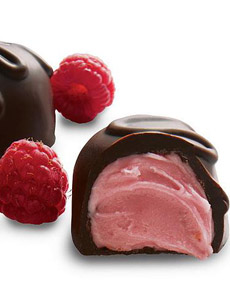TODAY IN FOOD: It’s National Creme-Filled Chocolates Day
|
Strawberry cream fills this chocolate bonbon from Fanny May. |
Fittingly, February 14, Valentine’s Day, is also National Creme-Filled Chocolates Day.
Cream-Filled chocolates were made possible by Jean Neuhaus, the Belgian chocolatier who invented the first hard chocolate shell in 1912. Using molds, it enabled fillings of any kind and consistency—creme, whipped cream, soft caramel, light ganache, liqueurs, etc. Previously, only solid centers like caramels and nut pastes could be enrobed in chocolate—anything else would have leaked out. In enrobing, the center—marzipan, fruit jelly or nuts in caramel, for example—were hand-dipped into liquid chocolate. The center had to be solid enough to be held and hand-dipped. With Neuhaus’ chocolate molds, chocolates could now be made in pretty shapes, too—flowers, butterflies, fleur-de-lis, crowns, berries and others that are now familiar to us. |
|
|
Thanks, Jean Neuhaus, for vastly expanding our world of chocolate bonbons. Today, bonbons with chocolate shells are known as Belgian style, and dipped chocolates as French style. Some chocolatiers work in only one style, some create a mixture of both. Chocolate shells have a thicker chocolate covering than dipped chocolate, so consumers have their preferences, based on whether they like more chocolate flavor or more flavor of the center. Read more about filled chocolates, a.k.a. bonbons, in our article on chocolate truffles and ganache in the Chocolate Section of THE NIBBLE webzine. The difference between cream and creme is just the spelling. Creme is an Americanization of the French word for cream, crème—pronounced KREHM, with l’accent grave, the downward sloping accent mark that turns the “e” sound into “eh.” Creme was most likely first used in the U.S. to make the dish sound more special: a creme pie versus a cream pie, for example. But why mispronounce and misspell another language’s word for cream, or create a new spelling when there’s a perfectly good and accurate existing word? That, dear reader, is the challenge of allowing “amateurs” to name things. In France, the Académie Française, established in 1635 by Cardinal Richelieu, is the pre-eminent authority for matters pertaining to the French language, and publishes an official dictionary of the French language. In recent years, a committee of 40 had to rule on whether newer words like “le computer” are permitted in the dictionary, as opposed to French for “a machine that computes information.” Back to creme vs. cream: Unless it’s a French recipe with an appropriate accent, such as Coeur à la Crème, stick to cream. |
||



